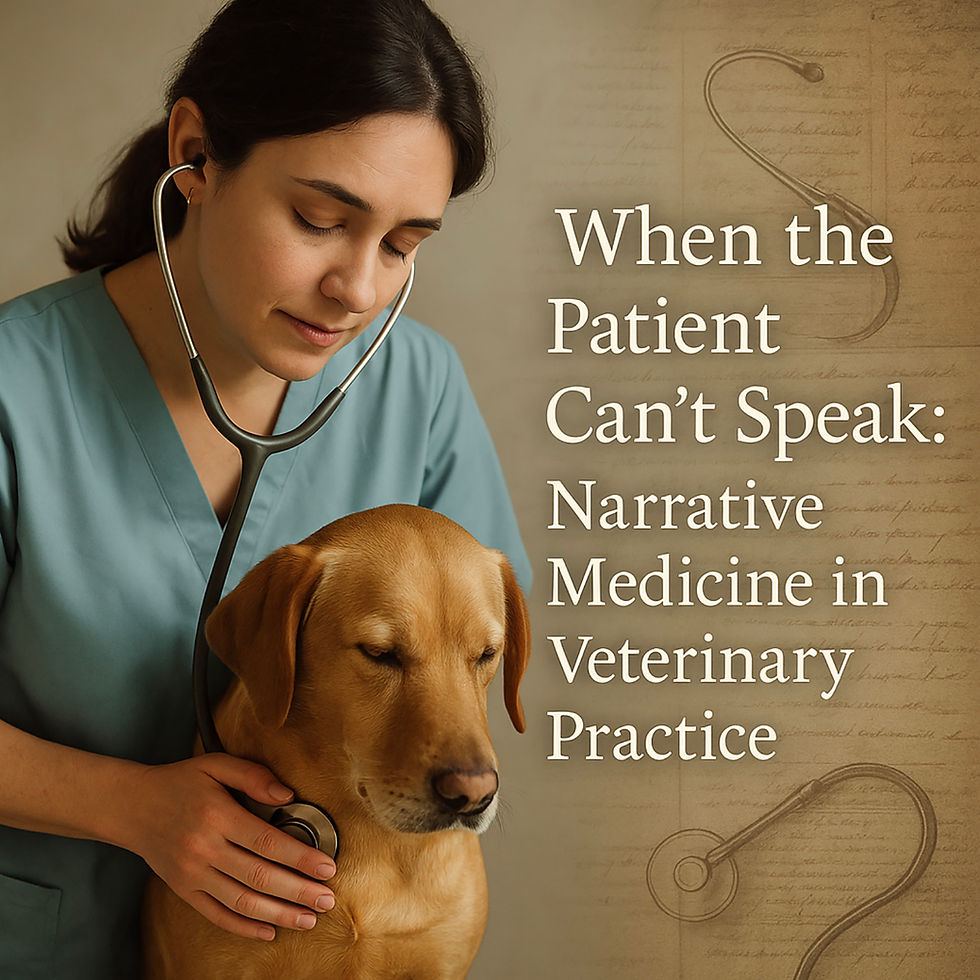Silent Stories: Rethinking narrative medicine for animals (#382)
- Rick LeCouteur
- Aug 3
- 3 min read

In human healthcare, narrative medicine emerged in the early 2000s as a response to the increasing depersonalization of modern medical practice.
Spearheaded by Dr. Rita Charon at Columbia University, the field emphasized the importance of listening to the patient’s story to deliver better, more compassionate care. Not just observing their symptoms.
Charon argued that storytelling is central to healing, and that clinicians trained in narrative competence could more deeply understand the lives of their patients, build trust, and improve outcomes.
But what happens to narrative medicine when the patient cannot speak?
In veterinary medicine, we treat patients who live rich lives but cannot share their own illness stories in words. They cannot describe the onset of their pain, the quality of their nausea, the shape of their fear.
So, are veterinarians disqualified from practicing narrative medicine?
Or are we simply called to redefine it?
The Proxy Narrators
In the veterinary field, the stories often arrive secondhand. Owners, farmers, zookeepers, wildlife rescuers become the proxy narrators for our patients. They frame the timeline, interpret behavior, note what has changed. Their narratives are filtered through observation, emotion, and sometimes guilt or fear.
A dog "just hasn’t been himself."
A horse is “reluctant” to enter the trailer.
A cat “seems to know something’s wrong.”
These are clues. They are imperfect, colored by language and assumption, but they are valuable. Just as a pediatrician interprets a parent’s report about a pre-verbal child, so too must the veterinarian listen deeply:
Not only to what is said, but how it is said.
Silent Stories: Reading the Animal
But the animals themselves do tell stories. Just not in words.
They tell them in posture and gait, in appetite and alertness, in the subtle flick of an ear or the lurch of a limb. They narrate through physiology. Fever, arrhythmia, anemia. And through silence.
The skilled veterinarian learns to read these nonverbal cues with the sensitivity of a linguist decoding a long-lost dialect.
In this way, veterinary medicine becomes a form of translational narrative. The vet is both interpreter and detective, piecing together the narrative arc of a case from physical clues, owner memories, and clinical data. The story may be incomplete, but it is still a story.
When Technology Obscures the Story
As veterinary medicine grows more specialized and technology-driven, it’s easy to lose the narrative thread. CT scans, lab panels, MRIs are extraordinary tools. But they can reduce the patient to images and numbers unless we remain grounded in context.
A subtle limp in a working sheepdog means something different than in a geriatric poodle.
The same pathology carries a different emotional and economic burden in each family.
Narrative medicine reminds us to see the entire picture.
A New Name?
Some argue that narrative medicine may not be the best term for the veterinary profession. After all, the patient in veterinary medicine is mute, at least in the human linguistic sense.
Alternatives have been proposed:
Interpretive Veterinary Medicine
Empathic Practice
Contextual Care
Narrative Listening in Veterinary Medicine
But perhaps it is precisely because our patients do not speak that narrative medicine matters more, not less.
We must listen harder, think more holistically, and engage more deeply with the humans who speak on their behalf.
Rick’s Commentary
In veterinary medicine, the story is always collaborative.
It includes the silent animal, the observant (or not-so-observant) owner, the clinician who probes and reflects, and the tools that reveal hidden truths.
Practicing a form of narrative medicine means embracing this complexity and recognizing that healing is not just a matter of treatment, but of understanding.
When the patient cannot speak, it becomes our duty to listen even more carefully.
Further Reading
Rita Charon, M.D., Ph.D. https://sps.columbia.edu/person/rita-charon-md-phd



I love this so much